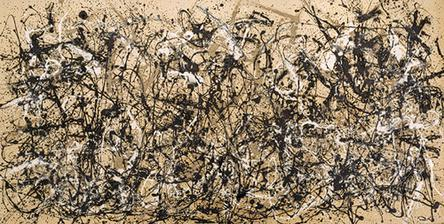Early Modern Art
Styles That Emerged After World War I
In the late 19th and early 20th century, early modern art steered away from what we call traditional art. It has had a lasting impact on different cultures worldwide. Rather than using dark colors for their paintings, they switched to very bright and vibrant colors. They used more forms of shapes and moved away from traditional drawing. After World War I, people were so horrified that they were ready for change and ready to rebuild.
Autumn Rhythm
Artist: Jackson Polluck
Enamel on canvas
Displayed at The Metroploitan Museum of Art, New York City
This painting depicts emotional turmoil. He uses just three colors: black, white, and a tanish color. The paint is splattered throughout the canvas. There is no particular shape form. There are no particular lines in this painting. I also feel like there could be some type of emotional anger in this piece of work.
This painting is interesting, but I don't think I would own a piece of work. This painting reminds me of the movie The Upside. A movie where a young colored man is hired as a helper for a paralyzed rich man. He splatters paint on canvas, and the paralyzed man helps him out and sells that artwork for thousands of dollars. He could not believe splattered paint art was worth a lot of money. This painting reminds me of that movie.
💐💐💐
The Tree of Life
Artist: Seraphine Louis
Oil Paint and unknown added substances
Louis is a painter who loves floral arrangements. In this painting, she paints limbs from a tree covered in ripe fruit and small flowering bushes. She also uses dots and feather-like shapes. She uses a range of darker colors, such as different shades of black, blues, reds, and oranges. Her paintings are different from other paintings, as they contain some type of waxy unknown substance.
I would own a painting of this. This tree of life also reminds me of how family grows and branches out. Each branch has its own style; no branch is the same. Or it reminds me of each generation of change with the changing of colors.
🌺🌺🌺
Mountains and Sea
Artist: Helen Frankenthaler
Oil and charcoal on canvas - Nataional Gallery of Art, Washington, D.C.
This painting of the mountains and sea uses fresh-colored paint. She uses lighter shades of blue, peaches, and yellows, all of which bring brightness to her painting. There are no specific lines, just sketches that outline the mountain and the sea. This is a painting of one of her visits to Nova Scotia. She uses more of her emotions to depict this painting than the exact painting of the area she visited. She uses diluted paint to make the color lighter.
This is another painting that I would hang either in my house or an office. It would brighten up a room. This is a great painting depicting change after going through the tragic wars everyone endured at that time.
Sources:
art-mus-thr200. Art 200x, 24 Apr. 2009, art200.community.uaf.edu/2009/04/24/03-visual-art-2/.
“Abstract Expressionism Movement Overview.” The Art Story. n.d. Web. 04 Apr. 2024.
“Art Brut and Outsider Art Movement Overview.” The Art Story. n.d. Web. 04 Apr. 2024.
“Abstract Expressionism: Second Generation Movement Overview.” The Art Story. n.d. Web. 04 Apr. 2024.



I was particularly drawn to the painting “The Tree of Life”. The shape of the tree is particularly unnatural. It feels like it is cramped within the composition- conforming to the surrounding shape of the land and edge of the paper. In addition, the colors used look so dark and fiery. It gives off the impression of fire and reminds me of a hell style landscape. I find that particularly ironic given the title of the work. If anything this tree of “life” feels hopeless. That may have been done purposefully given the time period of WW1 and the inspiration that the aftermath of the wars death and destruction likely had on it.
ReplyDeleteI love that you chose to feature Jackson Polluck in this post! He's an artist that has always stood out to me! I do think you made a good selection displaying different art pieces that reflected some views on wanting to remain optimistic for the future, especially after the horrific world wars. It does seem like there are a lot of various non-traditional styles that have emerged after these wars that have also became more popular. I wonder if newer art styles also reflect not only the artists' but societies' views on traditional art and values as well.
ReplyDelete